Cover picture: Christoph Läser
Interview: Antje Giger, Belinda Steinmann
Images: Christoph Läser, Antje Giger
Antje, you spent ten days in Georgia in March 2022 on behalf of Orthotec. What was this aid mission about?
We visited families with severely disabled children and young adults in their homes. In rural areas, the therapeutic and medical infrastructure is poor. We adapted the young people's wheelchairs and repaired them. At the same time, we provided further training for the local experts.
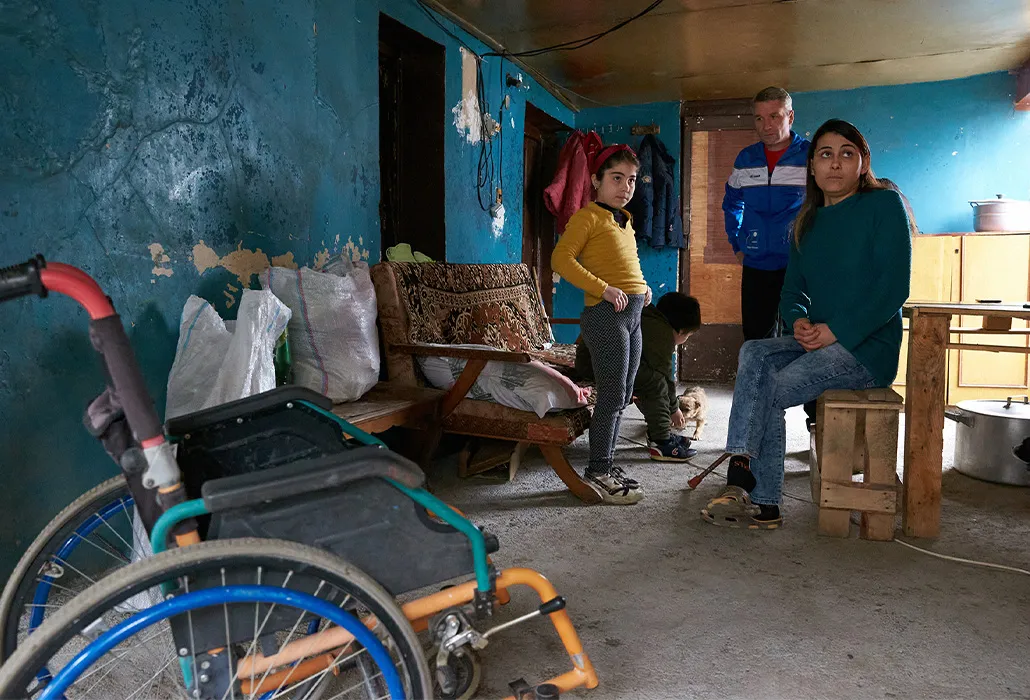
Nicoloz and his family. His wheelchair is faulty. Image Christoph Läser
What did you have to do specifically?
There was eight-year-old Nicoloz, for example. He has a progressive spinal cord disease and can only walk with great difficulty now. His wheelchair was outside in the yard with flat tyres. The footrests were missing and various parts had broken off. A young woman was barely able to get out of bed anymore because her wheelchair was unsuitable and faulty. Or there is the example of Lasha, a young man with cerebral palsy and extension spasms, which means that his locomotor system is limited and his muscles are under excessive tension due to brain damage caused at birth. Instead of sitting, Lasha was lying on numerous cushions and blankets in a jalopy that was far too wide for him. There was a brand new wheelchair outside his door, which had never been used because nobody could adapt it.
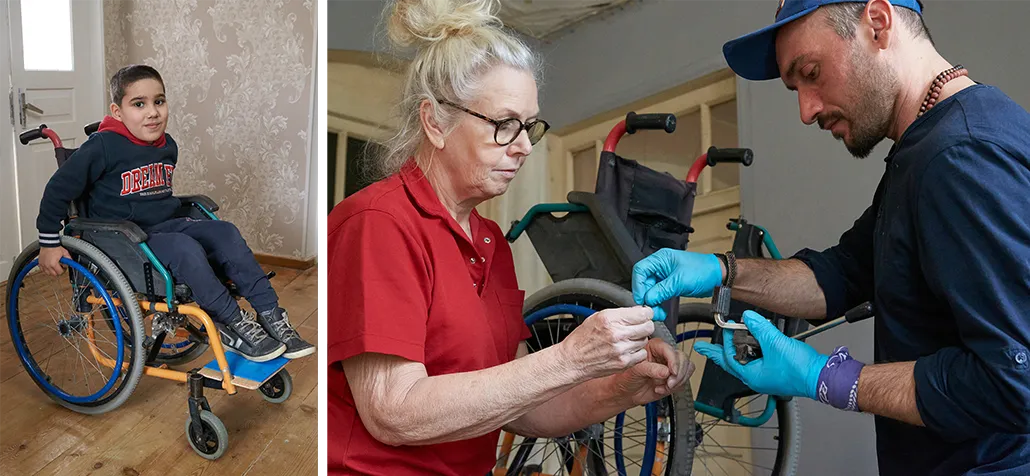
Left: Nicoloz sits happily in his reconditioned wheelchair with its new footrest.
Right: Orthotec employee Antje provides further training in wheelchair mechanics for Georgian expert Bacho. Images Christoph Läser
How did this placement come about?
The MTE association asked Orthotec if we wanted to support the project in the long term. I was really interested in their presentation and then enrolled for the first placement with our team. Despite the impressive stories and images, we only had a vague idea of what we would find when we got there and which material we would need. In my 30 years of professional experience, I have adapted and repaired numerous wheelchairs, developed special solutions and implemented seat shells to allow wheelchair users to sit upright. I wanted to use this knowledge to help the people in Georgia and also wanted to provide an insight for my colleagues for their upcoming placements, as Orthotec had committed to long-term cooperation.
«People are not yet aware of the benefits for wheelchair users of a correctly adapted wheelchair.»
After a few months’ delay due to coronavirus, you finally set off in March 2022. Who did you travel with?
We were a team of three from Switzerland: Martin Haug and Fenja Läser, who have been managing the project from the outset, and I. I took replacement parts, seat cushions and material to adapt seats with me. At the last minute, I also packed a replacement wheelchair as I had seen photos relating to upcoming home visits. They showed enormous wheelchairs that were so broken that you hardly knew where to start with repairs. There was one where you could see straight away that it could no longer be salvaged.
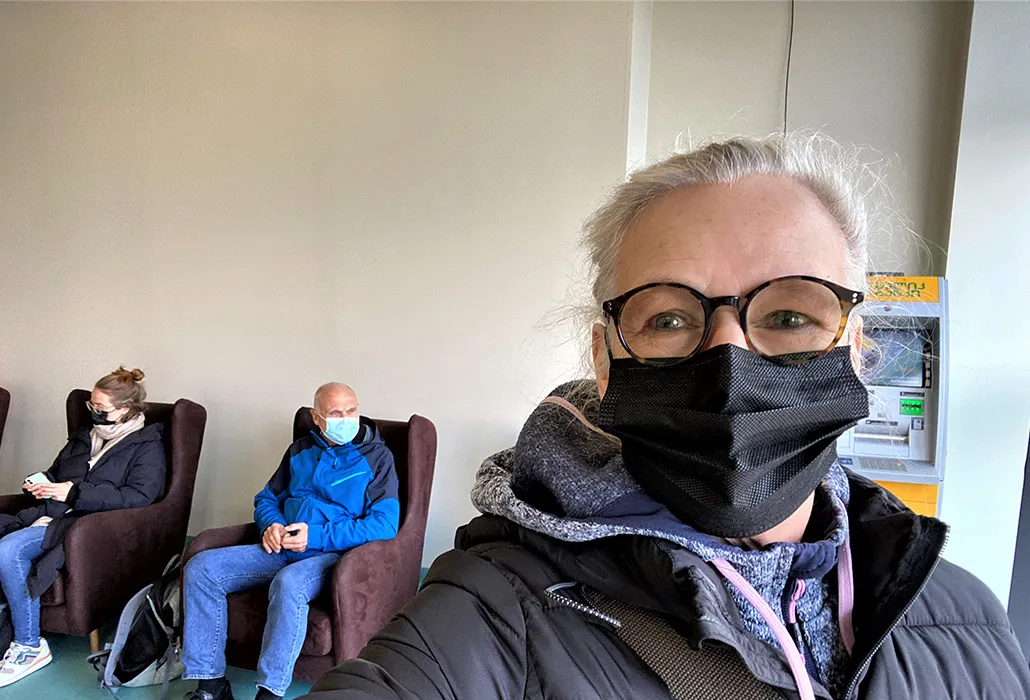
The trio from Switzerland is en route. Image Antje Giger
Why don't the people have better aids?
Although there is a state programme in Georgia for dispensing wheelchairs in three standard sizes to children up to the age of 18, it only includes 40 wheelchairs a year. Due to their growth, children need a new wheelchair every two years. This almost never works out due to the long waiting list. The average income in Georgia is about 350 lari per month, which is the equivalent of about 120 Swiss francs. A wheelchair costs 1000 lari. This means that only very few people are able to buy a wheelchair privately. And the second issue is that the knowledge and opportunities to adapt the wheelchair to the person are lacking. This results in poor posture, pain and pressure sores.
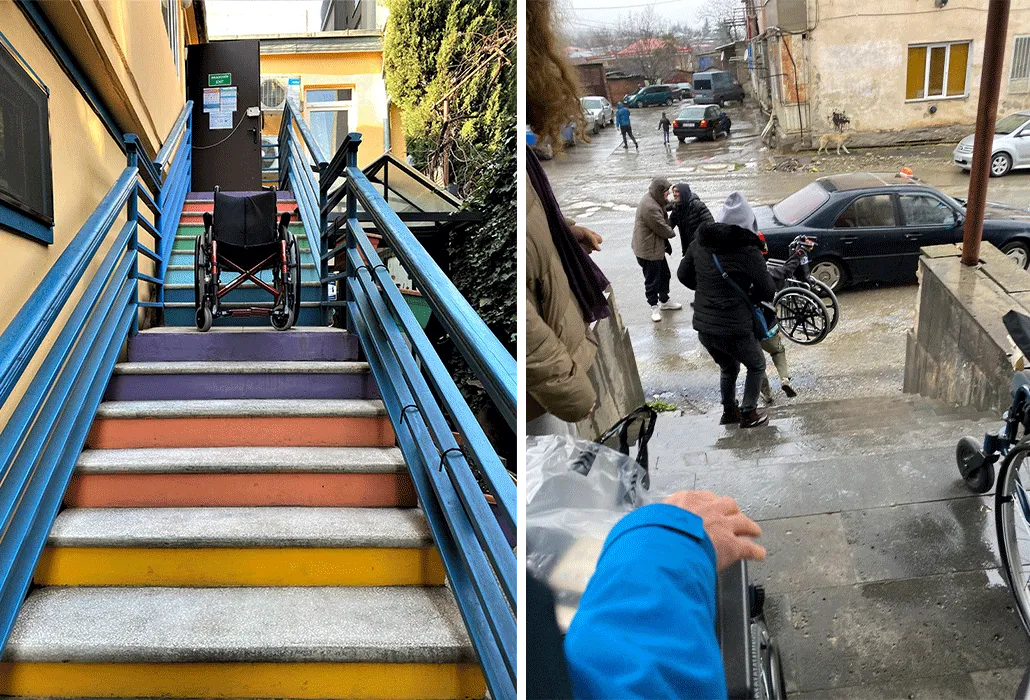
Far removed from barrier-free – access to private and public buildings. Images Antje Giger
And then you arrived in Georgia. What was your first impression?
We landed in the capital city Tiflis at night. As soon as we got to the hotel, I realised what things were like in terms of wheelchair accessibility in Georgia. There were 30 steps up to the entrance and we had to carry up all our material including the wheelchair. We managed it together and treated ourselves to a few hours’ sleep.
What were your first activities?
We used to the first two days in Tiflis for project discussions and visits. We then travelled to the province of Kakheti and set up our provisional workshop. The plan was to travel to Gurjaani and to Tsnori, two remote towns in Kakheti. The time schedule was eight days for eight people and their wheelchairs. I got to know the local members of the project: Shukia and Meri, the nurses responsible for the nursing part of the home visits, project manager Miranda, interpreter Elene, and Keti and Bacho, the experts for wheelchair adaptation who I was to provide further training for, and many others who all helped in some way during workshops for the families. We received an extremely warm welcome wherever we went.
«Dato was using his wheelchair on his own for the first time in years.»
How were the home visits for you?
They were unforgettable, enriching and freezing cold. Winter had returned and brought snow with it. We passed a car in the ditch by the side of the road. We stopped and, together with other drivers, pushed it back onto the road. As opposed to the police who simply drove past. First we visited all the families and recorded what we could improve. Then we used helpers and taxis to transport the wheelchairs to our workshop. People in Georgia are very willing to help. Everyone around us got involved in some way. We repaired, optimised and improvised, and later delivered the aids back to the families’ homes. There we made the final adjustments and instructed the family members. For example, about how to use the wheelchair properly, about the best way to transfer the person in and out of the wheelchair, and about how to position towels and cushions correctly in order to support the seating position.
You mentioned having to improvise?
Absolutely! I learnt how to make usable aids out of scrap and the few materials I’d brought with me. Although there are puncture-resistant tyres, they also break if you run them into a hot oven. The old tyre had melted onto the plastic rim. A new tyre of this kind was not available in Georgia and the one we had brought with us was too wide. So we had to trim it to size using a scalpel. We carved, stuck, sewed and made new suitable models out of old seat cushions, we created seat shells out of wood and foamed material, and customised lap belts for improved support.
How did the wheelchair users react to your work?
Most of them were very happy and grateful. But not all of them could express themselves. And the grandfather of one boy even asked if it was necessary to adapt wheelchairs? I was lost for words for a moment there. People are not yet aware of the benefits for wheelchair users of a correctly adapted wheelchair.
What are those benefits specifically?
In a nutshell: freedom of movement. Fewer dangerous pressure sores, less pain, more possibilities. Take wheelchair user Dato as an example: he was more lying than sitting in his wheelchair because he couldn't bend his hip joint properly. Since an operation several years ago, he had never been able to use his wheelchair on his own. In our workshop, I carved him a cushion out of foamed material to take the pressure of the area of his hip and to enable him to sit upright. I also mounted a belt system to ensure a secure hold. However, when we gave him his adapted wheelchair, Dato didn't want to sit up and showed us that. He sat in a worse position than before and, the more we tried, the worse things got. I started to wonder whether I was in the right job. We stopped the fitting session and postponed it to the next day. As we were heading for the door, he suddenly started following us independently. Dato was using his wheelchair on his own for the first time in years.
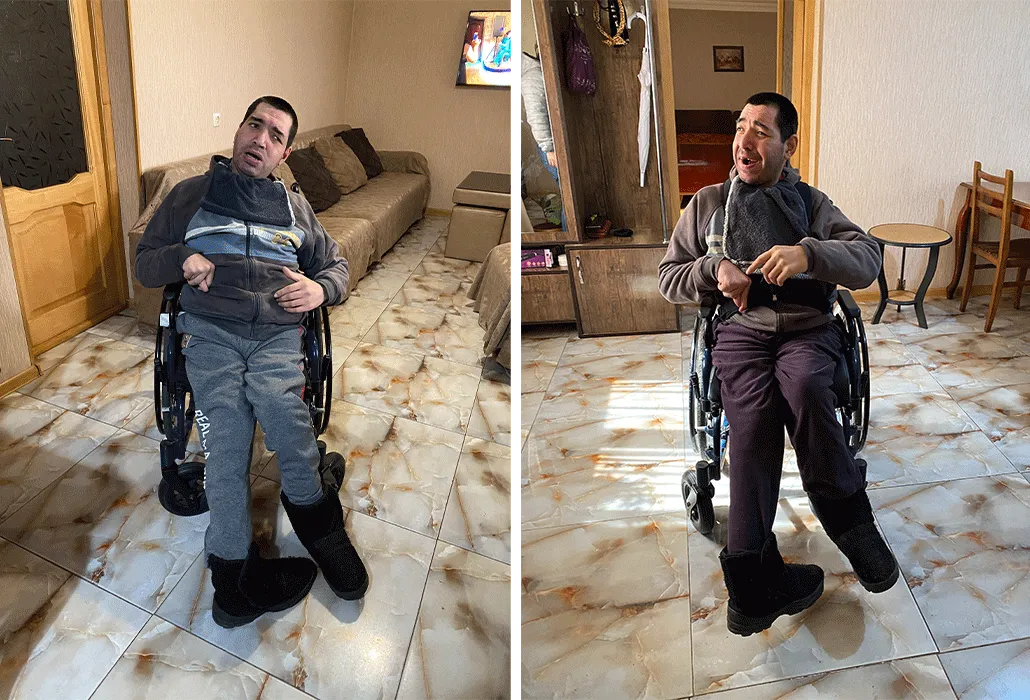
Left, before: Dato is lying down and not moving in his wheelchair.
Right, after: He is sitting in a more upright position and can finally move around again. Images Antje Giger
A fantastic result. What are the other consequences of your work?
Local experts were able to extend their specialist knowledge. We also filmed several instructional videos during the work. There was one seat shell that I was no longer able to complete so I instructed Keti and Bacho in the necessary steps.
The days in Georgia simply flew by. I didn’t have time to visit the beautiful country. I would love to go back another time to do so. I got to know open, kind and committed people. I experienced significant differences between urban and rural areas and saw people living in complete exhaustion and poverty. The training and education of local people is a big step in the right direction – even if there is still a long way to go.
A day after I got home, I was sent photos of a young man smiling happily in his new wheelchair with a seat shell. Keti and Bacho’s first independent work was a resounding success.
Werden Sie jetzt Mitglied und erhalten Sie im Ernstfall 250 000 Franken.


